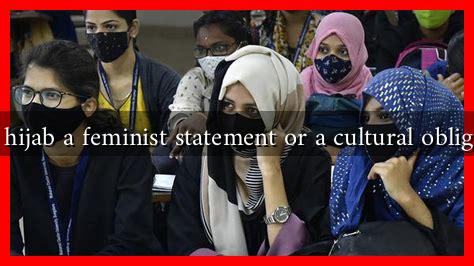-
Table of Contents
Is the Hijab a Feminist Statement or a Cultural Obligation?
The hijab, a headscarf worn by many Muslim women, has sparked intense debate regarding its significance. Is it a symbol of empowerment and feminist expression, or is it merely a cultural obligation imposed by societal norms? This article delves into the complexities surrounding the hijab, exploring its multifaceted meanings and the diverse perspectives of women who choose to wear it.
The Historical Context of the Hijab
The hijab has a rich history that predates Islam, with roots in various cultures and religions. In ancient civilizations, head coverings were often worn by women as a sign of modesty and respectability. With the advent of Islam in the 7th century, the hijab became associated with religious identity and moral values.
- Religious Significance: In Islamic tradition, the hijab is seen as a commandment from God, intended to promote modesty and protect women from objectification.
- Cultural Variations: The style and significance of the hijab can vary widely across different cultures, from the simple scarf to more elaborate forms like the burqa or niqab.
The Feminist Perspective
For many women, wearing the hijab is a personal choice that embodies their feminist beliefs. They argue that the hijab allows them to reclaim their bodies and assert their autonomy in a world that often objectifies women.
- Empowerment through Choice: Women who choose to wear the hijab often describe it as a form of empowerment. They assert that their decision to wear the hijab is a conscious choice that reflects their identity and beliefs.
- Resistance to Objectification: By covering their hair and bodies, some women feel they are resisting societal pressures to conform to Western beauty standards, thus reclaiming their narrative.
For instance, a study conducted by the University of California found that Muslim women who wear the hijab often report higher levels of self-esteem and body positivity compared to those who do not. This suggests that, for some, the hijab serves as a powerful tool for self-affirmation.
Cultural Obligations and Societal Pressures
Conversely, many women face societal and familial pressures to wear the hijab, which can transform it from a personal choice into a cultural obligation. In some communities, not wearing the hijab can lead to social ostracism or familial disapproval.
- Social Expectations: In certain cultures, wearing the hijab is seen as a rite of passage or a requirement for being considered a “good” Muslim woman.
- Legal and Institutional Pressures: In some countries, laws mandate the wearing of the hijab, limiting women’s freedom to choose. For example, in Iran, women are legally required to wear the hijab in public.
These pressures can lead to a complex relationship with the hijab, where women may feel compelled to wear it despite personal reservations. A survey by the Pew Research Center indicated that 62% of Muslim women in countries where the hijab is mandated reported feeling pressured to conform to these norms.
Case Studies: Diverse Experiences
To illustrate the varied experiences of women regarding the hijab, consider the following case studies:
- Malala Yousafzai: The Nobel laureate and education activist wears the hijab as a symbol of her faith and identity, using her platform to advocate for women’s rights and education.
- Women in France: In France, where the hijab is banned in public schools, many Muslim women express feelings of exclusion and discrimination, highlighting the challenges of navigating cultural identity in a secular society.
Conclusion: A Personal Journey
The hijab embodies a complex interplay of personal choice, cultural obligation, and feminist expression. For some women, it is a powerful statement of identity and autonomy, while for others, it may represent societal pressures and expectations. Ultimately, the significance of the hijab varies widely among individuals, shaped by personal beliefs, cultural backgrounds, and societal contexts.
As discussions around the hijab continue, it is essential to recognize and respect the diverse experiences of women who wear it. Understanding the hijab as both a feminist statement and a cultural obligation allows for a more nuanced conversation about women’s rights, identity, and autonomy in a global context.
For further reading on this topic, you can explore resources from Pew Research Center and UN Women.

